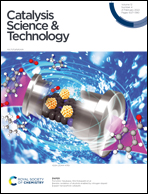Assessing the functional groups in activated carbons through a multi-technique approach†
Abstract
Activated carbons play a key role in catalytic applications thanks to the possibility to tune their surface chemistry through the change of the precursor or of the activation treatment. However, the characterization of their surface species is not straightforward. Herein, we present the potential of a multi-technique approach, based on an alternative temperature programmed desorption-infrared spectroscopy (TPD-IR) method coupled with TGA, elemental analysis and Boehm titration measurements, for the simultaneous identification and quantification of functional groups in activated carbons. We employed this method for characterizing seven carbons used in catalysis, differing in precursors, activation routes and post-activation treatments. The novelty of our TPD-IR approach relies in the choice of accumulating the gaseous decomposition products while maintaining the necessary low-pressure levels. The univocal detection of released gases by IR spectroscopy permits the quantification of those released at high concentration (CO2 and CO) as well as those produced at trace levels (e.g. CH4, NO). Moreover, H2O may be quantified, giving information on the fraction of functional groups close enough to condense. Even though this type of characterisation remains a challenging task, our alternative TPD-IR approach appears as a promising and versatile new option to identify and quantify the surface functional groups on different carbon materials, which hopefully will benefit from a wider and more thorough validation by independent research groups in the near future.



 Please wait while we load your content...
Please wait while we load your content...